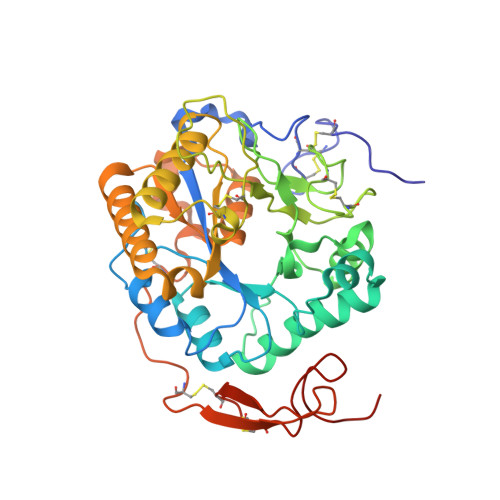Structural and biochemical insights into the catalytic mechanisms of two insect chitin deacetylases of the carbohydrate esterase 4 family.
Liu, L., Zhou, Y., Qu, M., Qiu, Y., Guo, X., Zhang, Y., Liu, T., Yang, J., Yang, Q.(2019) J Biological Chem 294: 5774-5783
- PubMed: 30755482
- DOI: https://doi.org/10.1074/jbc.RA119.007597
- Primary Citation of Related Structures:
5ZNS, 5ZNT - PubMed Abstract:
Insect chitin deacetylases (CDAs) catalyze the removal of acetyl groups from chitin and modify this polymer during its synthesis and reorganization. CDAs are essential for insect survival and therefore represent promising targets for insecticide development. However, the structural and biochemical characteristics of insect CDAs have remained elusive. Here, we report the crystal structures of two insect CDAs from the silk moth Bombyx mori : Bm CDA1, which may function in cuticle modification, and Bm CDA8, which may act in modifying peritrophic membranes in the midgut. Both enzymes belong to the carbohydrate esterase 4 (CE4) family. Comparing their overall structures at 1.98-2.4 Å resolution with those from well-studied microbial CDAs, we found that two unique loop regions in Bm CDA1 and Bm CDA8 contribute to the distinct architecture of their substrate-binding clefts. These comparisons revealed that both Bm CDA1 and Bm CDA8 possess a much longer and wider substrate-binding cleft with a very open active site in the center than the microbial CDAs, including Vc CDA from Vibrio cholerae and Ar CE4A from Arthrobacter species AW19M34-1. Biochemical analyses indicated that Bm CDA8 is an active enzyme that requires its substrates to occupy subsites 0, +1, and +2 for catalysis. In contrast, Bm CDA1 also required accessory proteins for catalysis. To the best of our knowledge, our work is the first to unveil the structural and biochemical features of insect proteins belonging to the CE4 family.
- From the State Key Laboratory of Fine Chemical Engineering, School of Life Science and Biotechnology and School of Software, Dalian University of Technology, Dalian 116024, China.
Organizational Affiliation:



















